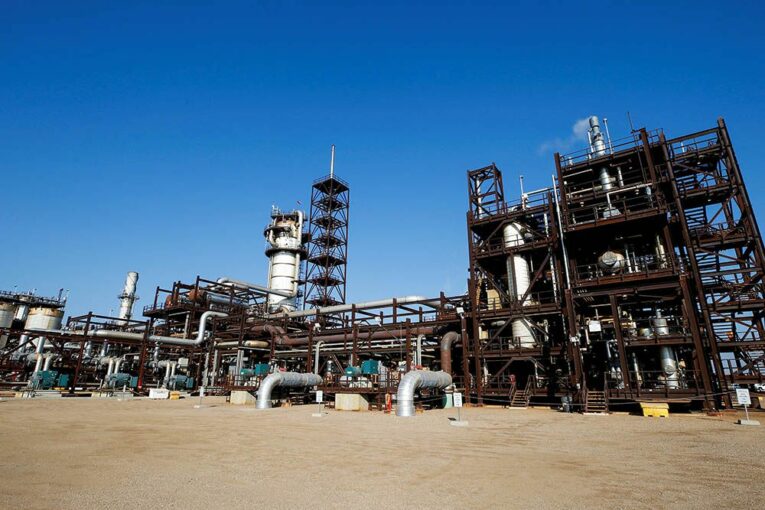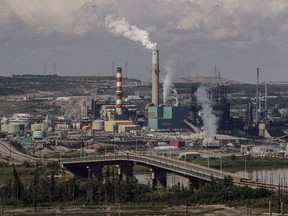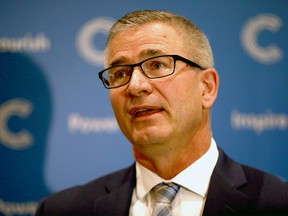
Ottawa has put its marker on the table by providing a multibillion-dollar tax credit to companies willing to make big investments in carbon capture and storage projects in the country.
Will Premier Jason Kenney’s government do the same in Alberta?
The Liberal government extended an olive branch to the oilpatch in its budget on Thursday, providing details on a federal investment tax credit for carbon capture, utilization and storage (CCUS) developments.
It arrives as Prime Minister Justin Trudeau’s government is moving ahead on aggressive climate plans, which include a cap on emissions from the oil and gas sector, beginning in 2025.
The new tax credit quickly garnered support from industry leaders while getting mixed reviews from the province.
“We love the first step, think it’s a good number. Could it have been stronger? Sure. But we don’t think it’s a fatal flaw,” said Michael Belenkie, CEO of Advantage Energy, a mid-sized producer that is pursuing carbon capture and storage developments.
“Overall, (we’re) pleased that it was included,” added Finance Minister Travis Toews. “We are not sure that this is going to be enough.”
The budget now puts pressure on the Alberta government to pony up some money if it wants to get the ball rolling faster on CCUS projects, which capture carbon dioxide emissions and store them deep underground or use them in other processes.
Getting the investment conditions right will be critical if Ottawa wants to trigger a wave of new capital spending by industry and also significantly curb emissions from the oil and gas sector by 2030.
“Our members are telling us this will be enough to get started,” said Adam Legge, president of the Business Council of Alberta.
The tax credit will be set at 60 per cent for investments made in equipment for direct air capture developments, and 50 per cent for investments in equipment to capture CO2 in CCUS projects.
It will also provide a 37.5 per cent credit for spending on equipment used for transportation and storage in such developments.
The budget document also says it will “engage with relevant provinces in the expectation that they will further strengthen financial incentives to accelerate the adoption of CCUS technologies by industry.”
Hello, Alberta.
That is a nifty way of throwing the ball back in the court of the Kenney government, a major supporter of using the technology to lower emissions in the province and ensure the energy sector’s long-term future in a net-zero world.
“It is a subtle nudge to the province to come to the table,” said Legge.
Earlier this week, the head of the Canadian Association of Petroleum Producers said the group was looking for a 75 per cent tax credit.
While the federal announcement didn’t hit that mark, it took a step forward for companies now considering investments in CCUS, said MEG Energy CEO Derek Evans.
MEG is part of the Oilsands Pathways to Net Zero Alliance, a group of six companies working together to reach net-zero emissions by 2050. The alliance has proposed building a CO2 trunk line connecting more than 20 oilsands facilities, primarily in the Fort McMurray area, to an underground storage hub near Cold Lake.

The first phase of its CCUS project could reduce oilsands emissions by 10 megatonnes annually by 2030. It would cost in the neighbourhood of $14.5 billion, Evans said.
It would also create thousands of construction jobs in Alberta and ensure a long-term royalty payment stream as the province becomes a preferred global supplier of net-zero oil.
The alliance had called for a tax credit in the range of 75 per cent and said the province “could bridge the difference,” Evans said.
“We have seen the federal government step up to the table with a 50 per cent number and challenge the province — not make it obligatory — but challenge them to step up,” he said.
“Until we see where the province gets to, I don’t think we’re really in a position to say whether we are a go or no go.”
In an interview, Toews pointed out Alberta has already made major investments in carbon capture and storage (starting under the Stelmach government) that have topped $1.8 billion.
But should Alberta make up the gap between what the Trudeau government offered and what the energy industry is seeking?
“I would suggest not,” Toews replied.
“These were federal emissions targets and the federal government needed to ante up and ensure that this (investment tax credit) was calibrated appropriately.”

What is abundantly clear is carbon capture and storage will be needed if Canada is to meet its climate ambitions, cutting total emissions in the country 40 to 45 per cent below 2005 levels by the end of the decade.
The International Energy Agency has reinforced the need for CCUS, calling it an important emissions reduction technology and noting more than 100 new facilities were announced around the world last year.
Canada aims to reduce emissions by at least 15 megatonnes annually with CCUS. The budget says a refundable credit will be available beginning this year for businesses that spend money on developments that permanently store captured CO2 or utilize it in industrial processes — although it specifically excludes enhanced oil recovery projects.
That puts it at odds with a similar U.S. incentive.
Tristan Goodman, president of the Explorers and Producers Association of Canada, said the tax credit is constructive, although he was disappointed enhanced oil recovery projects were ruled out.
It’s expected the overall tax credit will cost $2.6 billion over five years, beginning this year, before hitting $1.5 billion annually.
Some environmental groups lambasted the feds for the new measure, but Jan Gorski of the Pembina Institute said the 50 per cent level was appropriate. Combined with other federal policies, such as a national price on carbon and the incoming clean fuel standard, it will provide an incentive for companies to invest.
In the oilpatch, Belenkie agreed.
“What this tax credit is about is increasing the number of projects that are potentially economic and it has to help,” he added.
“There is an opportunity — and the opportunity is real.”
Chris Varcoe is a Calgary Herald columnist.
You can read more of the news on source
